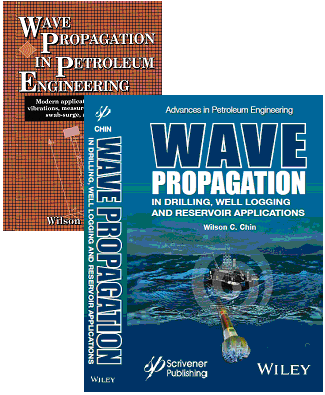WAVE
PROPAGATION AND
DRILLSTRING
VIBRATIONS
BACKGROUND

When the author began his wave propagation research at M.I.T., he asked, "Which problem(s) should I address? In fluids? In elastic systems? In ionized plasmas?" The sobering response, "All of the above," led to a Doctoral Thesis entitled Physics of Slowly Varying Wavetrains in Continuum Systems which encompassed all conceivable wave motions in general continuum systems.
The approach was unique. Assume that a "dispersion relation" (connecting frequency and wavenumber) were available. Using "variational principles," all mathematical outcomes were derived and translated into physical laws related to group velocity, energy and momentum, which were generally applicable. While abstract, the results would have far-reaching consequences in many areas of petroleum engineering. The author's thesis, which forms the first part of Wave Propagation, develops general mathematical methods and tools in "plain (readable) English." Then, the surprises come.
DRILLSTRING
VIBRATIONS

Half of Wave Propagation focuses on drillstring vibrations. Axial models allow area changes, rock-bit interation, bit bounce and rate-of-penetration. Torsional vibrations, coupled with general axial models, permit formation-dependent stick-slip motions. Both modes, taken together with lateral vibration models, describe the realistic vibrations encountered in real-world drilling. Many questions are answered.
For example, why do drillstrings fail at the neutral point? Why does this location, dependent solely on axial load distributions, figure prominently in lateral bending failures? And why is the high-cycle fatigue associated with such catastrophic failures not detectable from the surface? But alas, hope is offered by analyzing information contained in measured second-harmonic spectra.
MWD,
OCEAN
WAVES,
GEOPHYSICS AND
BOREHOLE
ACOUSTICS
We also introduce MWD telemetry, covered in detail in Measurement While Drilling, energy and momentum extraction from ocean currents (important to offshore platform design), geophysical ray-tracing in crosswell acoustic tomography, permeability prediction from Stoneley wave measurements, and acoustic logging response prediction in eccentric holes. And finally, an introduction to electromagnetic and resistivity logging is offered, subjects covered in detail in Electromagnetic Well Logging and Resistivity Modeling.
About Us
Home | Team Members | Papers | Patents | Books | Brochures | Contact |
Research, Science and Engineering
Home | Measurement While Drilling | Formation Testing | Fluid Rheology | Managed Pressure Drilling | Reservoir Engineering | Electromagnetic Modeling | Waves and Vibrations | Aerodynamics | Biomedical Imaging |
Copyright (C) 2025, by Stratamagnetic Software, LLC. All rights reserved.